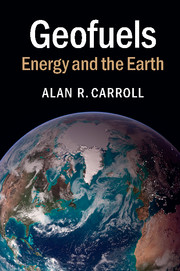Book contents
- Frontmatter
- Contents
- Acknowledgments
- 1 Introduction
- 2 The Living Earth
- 3 Warmed from Above: Solar Energy
- 4 Wind, Water, and Waves: Energy from the Fluid Earth
- 5 Covered in Green: Biofuels Basics
- 6 Fossil Farming: The Geologic Underpinnings of Biofuels
- 7 The Light of an Ancient Sun: Fossil Fuel Origins
- 8 Digging for Daylight: Coal and Oil Shale
- 9 Skimming the Cream: Conventional Oil and Gas
- 10 Stuck in the Mud: Fossil Fuels That Fail to Flow
- 11 Petrified Petroleum: Oil Sand and Gas Hydrate
- 12 Water, Water, Everywhere
- 13 Primordial Power: Geothermal and Nuclear
- 14 Out of Sight, Out of Mind: Geologic Waste Disposal
- 15 How Long Is Forever? Energy and Time
- 16 Conclusions
- Index
- References
12 - Water, Water, Everywhere
Published online by Cambridge University Press: 05 March 2015
- Frontmatter
- Contents
- Acknowledgments
- 1 Introduction
- 2 The Living Earth
- 3 Warmed from Above: Solar Energy
- 4 Wind, Water, and Waves: Energy from the Fluid Earth
- 5 Covered in Green: Biofuels Basics
- 6 Fossil Farming: The Geologic Underpinnings of Biofuels
- 7 The Light of an Ancient Sun: Fossil Fuel Origins
- 8 Digging for Daylight: Coal and Oil Shale
- 9 Skimming the Cream: Conventional Oil and Gas
- 10 Stuck in the Mud: Fossil Fuels That Fail to Flow
- 11 Petrified Petroleum: Oil Sand and Gas Hydrate
- 12 Water, Water, Everywhere
- 13 Primordial Power: Geothermal and Nuclear
- 14 Out of Sight, Out of Mind: Geologic Waste Disposal
- 15 How Long Is Forever? Energy and Time
- 16 Conclusions
- Index
- References
Summary
When the well's dry, we know the worth of water.
Benjamin Franklin (1706–1790), Poor Richard's Almanac, 1746Water, water, everywhere,
And all the boards did shrink;
Water, water, everywhere,
Nor any drop to drink.
Samuel Taylor Coleridge, “The Rime of the Ancient Mariner,” 1798Water is without doubt the most vital natural resource on Earth. Humans are mostly made of water, and without continual replenishment we cannot expect to live more than a few days. Even if we could, the plants that we depend upon for sustenance would quickly wither and die without water. Fortunately water is abundant on Earth, so much so that we tend to overlook its importance. The other planets in the solar system are not so fortunate, and that probably accounts for the apparent absence of life there. There is a chance that Mars did harbor life in the distant geologic past, and much of our exploration of that planet has focused on its history of water. Numerous canyons, dry river channels, and layered sedimentary deposits attest to the importance of water in originally shaping the Martian landscape. It has since become a hyperarid planet, however, where water appears to be confined to limited areas of polar permafrost.
The geological record of the Earth's first few hundred million years has almost entirely vanished, but what little evidence remains suggests that liquid water was already present at the Earth's surface as early as 4.4 billion years ago. Fortunately for us the Earth's overall water supply appears to be stable. By far the largest water resource is the ocean, which presently covers 71 percent of the planet's surface to a mean depth of nearly 4,000 m. As noted in Chapter 2, over the past 541 million years the depth of the ocean has remained surprisingly consistent, fluctuating only a few hundred meters at most.
- Type
- Chapter
- Information
- GeofuelsEnergy and the Earth, pp. 237 - 260Publisher: Cambridge University PressPrint publication year: 2015



